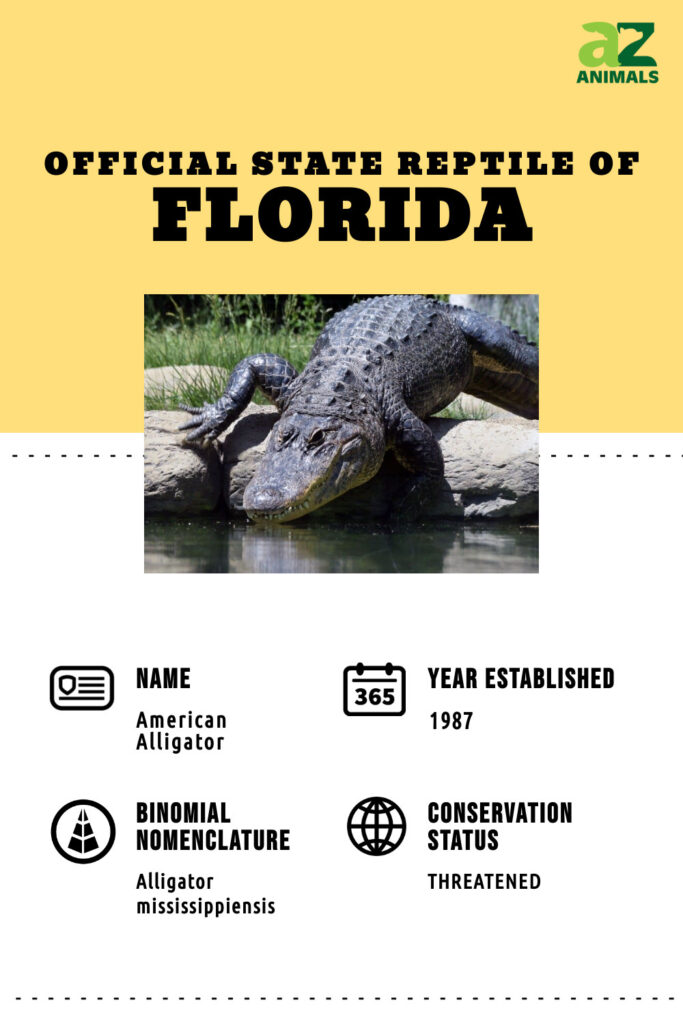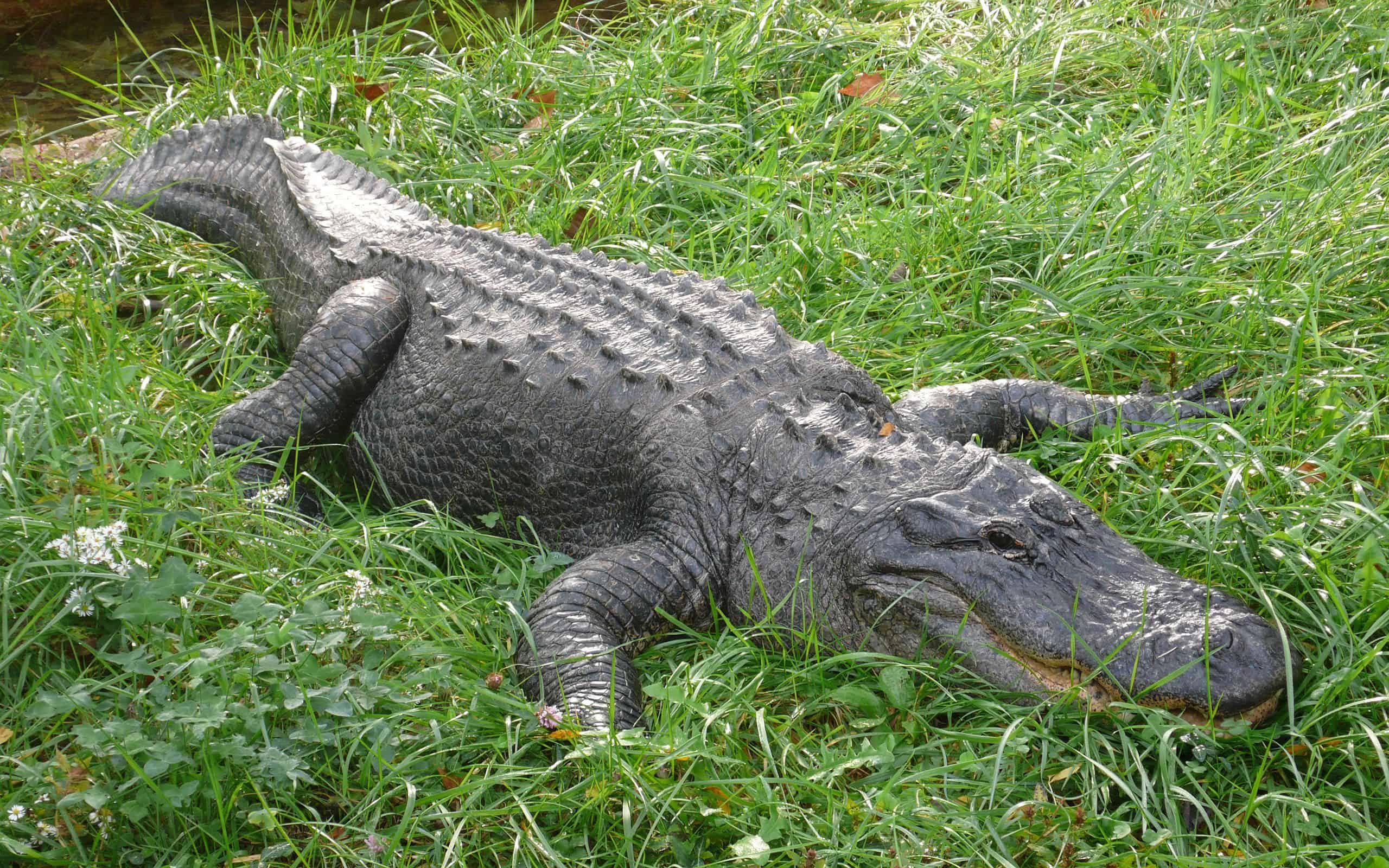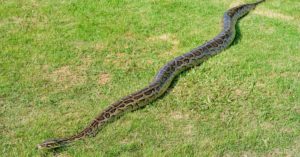Situated on the southeastern tip of the United States, Florida is well-known for its natural beauty and diverse wildlife. Florida’s official state reptile is the American alligator (Alligator mississippiensis) — one of the most iconic animals in the state. These powerful apex predators live throughout the state of Florida and have been present in the state since prehistoric times. Let’s take a closer look at the American alligator and see why this extraordinary animal is honored both within and outside of the Sunshine State.
The Official Florida State Reptile

The American alligator has a deeply rooted history in Florida.
©iStock.com/Cindy Larson
Florida’s state legislature designated the American alligator (Alligator mississippiensis) as the official Florida State Reptile in 1987. However, long before its “official” appointment, the American alligator had stood as an unofficial symbol of Florida, representing the state’s vast wilderness and swamplands, as well as its people’s strength, resilience, and pride.
The American alligator has a deeply rooted history in Florida. Alligators are closely associated with many Native American peoples who respected and named these animals as powerful symbols. Seminole groups, for example, caught alligators for meat and for their hides. Alligators were also important during ceremonies and were always regarded with the utmost respect. Today, the Miccosukee Village provides educational shows where they interact with alligators. These shows teach others about conservation and the unique roles these remarkable animals play in Florida’s environment.
The American alligator is one of only two alligator species on earth (the other is the Chinese alligator (Alligator sinensis)). American alligators live in much of the southeastern U.S., but they are especially well-known in Florida. In fact, Florida’s freshwater lakes, marshes, swamps, rivers, and canals are teeming with alligators. And of course, the Florida Everglades is too. Florida is home to 25% of all the alligators living in the entire United States!
In Florida, American alligators are the top predators of the Everglades. They are extremely important to the ecosystems in the state and have a large impact on other animals, including humans. The Everglades provide fresh drinking water for millions of people in Florida.

What Do American Alligators Look Like?

They have olive, gray, black, or brown backs, dark stripes on their tails, cream-colored bellies, and protective plates.
©TimVickers, Public domain, via Wikimedia Commons – License
American alligators are large reptiles with slightly rounded bodies and thick limbs. Males can grow up to 14 feet long and weigh up to 1,000 pounds! Females, on the other hand, rarely grow over 9 or 10 feet in length, but they are still quite formidable. There are various reports of alligators reaching lengths up to 17 feet and weighing more than 2,000 pounds. However, these are not officially verified.
We often think of alligators being green in color, but if you see a “green” alligator, it’s likely just covered in algae! Adult American alligators are some of the darkest crocodilians. They have olive, gray, black, or brown backs, dark stripes on their tails, and cream-colored bellies. They also have bony plates (called scutes or osteoderms) covering their bodies. These protect them like their very own built-in suit of armor.
It can be easy to mistake an American alligator for an American crocodile — crocodiles also live in Florida — but there are a few notable differences. For example, American alligators have larger, rounded snouts with 70 to 80 sharp teeth, while crocodiles have more slender snouts. In addition, when an American alligator closes its mouth, its large fourth tooth in the lower jaw tucks itself away into its upper jaw, so you cannot see it. On the other hand, you can definitely see the fourth tooth on the bottom jaw of an American crocodile.
What Do Baby Alligators Look Like?

Alligator hatchlings are only 6 to 8 inches long with bright yellow stripes on their tails.
©Wildnerdpix/Shutterstock.com
Baby alligators, or hatchlings, are fully formed and ready to hunt the moment they hatch from their eggs. Their mouths even come equipped with dozens of tiny but sharp, razor-blade-like teeth! Hatchlings look like miniaturized versions of their parents. They are only 6 to 8 inches long with bright yellow stripes on their tails.
American alligators breed in the springtime, gathering together in large groups and performing their “water dance” courtship rituals. Females lay 20 to 50 eggs around the end of June or the beginning of July in mound-shaped nests that they make from vegetation and mud. They incubate and aggressively guard their eggs for around two months until they hatch.
When baby alligator hatchlings emerge from their eggs, their mother helps them out of the nest and gently carries them in her mouth down to the water. When the baby alligators hatch, they look just like their parents, with yellow stripes that help them blend in. The babies stay close to their mother and make noises to let her know where they are. Their mother also does her best to stay close to her hatchlings for up to two whole years. Because of their size, hatchlings are vulnerable to other alligators, big fish, bobcats, birds, and raccoons.
American Alligators in Florida
As cold-blooded reptiles, American alligators regulate their body temperature externally by moving to warmer or colder areas. They like it best when the temperature is between 82° F to 92° F. They usually stop eating when it gets below 70° F. During the winter, they slow down quite a bit and sleep in burrows near alligator holes or water. If it’s a nice day though, they might come out of their homes and soak up some sunlight.
You are likely to see American alligators in Florida basking on logs or along riverbanks. They may appear sluggish, but don’t be fooled; these giant reptiles can move surprisingly fast when they want to, both on land and especially in the water. If an alligator exits a body of water, it can outrun a human for the first 20 to 30 feet of dry land! They are stealthy hunters and can remain silent and unseen for long periods of time.
American alligators are opportunistic feeders and eat animals that are easy to catch. Younger alligators, for example, typically hunt amphibians, insects, and small fish. Older alligators hunt larger fish, turtles, snakes, birds, and small to medium-sized mammals. They have large jaws with 70 to 80 sharp teeth for gripping and holding tightly onto their prey. Not much can escape a hungry American alligator — they have one of the strongest bite forces in the world, measuring over 2,000 pounds per square inch! However, they rarely hunt larger animals. Alligators prefer to stick with small animals that are more abundant and easier to catch. In Florida, American alligators primarily eat fish.
Are American Alligators Dangerous?
American alligators are apex predators, and they can be dangerous, although they do not actively hunt humans. Alligators in Florida look intimidating and can be dangerous if you do not respect them or their space. However, they are generally shy and avoid contact with humans. In fact, most of the time alligators either ignore humans or grow unsettled when humans are around.
However, it is important to always stay alert and be aware of your surroundings any time you are near water in Florida. Whether it is a man-made body of water or a natural one, there is a chance there could be an alligator in it. And chances are, you likely won’t be able to see it. Remember, alligators are stealthy animals that can remain still for a long time. Additionally, never walk small to medium sized dogs near lakes or ponds in Florida, especially without a leash. Staying mindful and respecting Florida’s wildlife can help to keep everyone safe.
On occasion, a hungry alligator may go after a small human or bite at human ankles, especially in areas that are encroaching on their natural habitat. You should always stay at least 50 feet away from alligators whenever possible. If an alligator bites you, make as much loud noise as you can. Poke at the alligator’s eyes, and use force if necessary to try to get away.
Are American Alligators Endangered?
American alligators are apex predators and have been around since the time of the dinosaurs. There hasn’t been much to challenge their position at the top of the food chain. However, when humans began hunting them, alligator populations quickly dropped. They were officially added to the Endangered Species Act of 1973. Fortunately, laws protecting American alligators, combined with conservation efforts, helped to bring the species back from the brink of extinction.
Today, the American alligator is no longer endangered, but it is still considered a threatened species. The main threat to these animals is the degradation and destruction of their wetland habitats. They are still protected by the Endangered Species Act. They are also a Federally-designated Threatened species by Florida’s Endangered and Threatened Species Rule.
American alligators are special animals that are important to the ecosystems of wetland habitats like the Everglades, both as apex predators as well as “ecosystem engineers.” American alligators are unique in that they modify their environment by building “alligator holes“. Using their strong back legs and large snouts, alligators clear away mud and muck from areas with limestone bedrock. This creates a miniature pond or a tunnel for protection and rest.
These alligator holes retain water throughout the year, even during the dry season. They act as an oasis during droughts for other animals living in the Everglades. In addition, alligators make their nests near their alligator holes, which often gives other animals a place to hide or build their own homes. So, as both apex predators and ecosystem engineers, Florida’s official state reptile plays a very important role in keeping the Everglades balanced and healthy.
The photo featured at the top of this post is © Steve Byland/Shutterstock.com
FAQs (Frequently Asked Questions)
What is the official state reptile of Florida?
The official state reptile of Florida is the American alligator (Alligator mississippiensis).
When was the American alligator designated as Florida's official state reptile?
The American alligator (Alligator mississippiensis) was designated as Florida’s official state reptile in 1987.
How long do American alligators live?
In the wild, American alligators typically live between 35 to 50 years. In captivity with the proper care, they often live around 60 to 80 years.
Does Florida have more alligators or crocodiles?
There are many more alligators than crocodiles in Florida.
Where can you see American alligators in Florida?
American alligators live in freshwater and brackish water. Some occasionally spend time in saltwater habitats. They can be spotted near ponds, rivers, lakes, swamps, and marshes, and prefer slow-moving water. The best time to look for them is in the early morning or late in the evening since this is when they are typically more active. American alligators can be difficult to spot, however, due to their camouflaged coloring, which helps them blend into their environment. They are also shy and try to avoid humans when possible, and are very skilled at hiding. And of course, remember to stay at least 50 feet away from any alligator and respect their space!
Thank you for reading! Have some feedback for us? Contact the AZ Animals editorial team.







